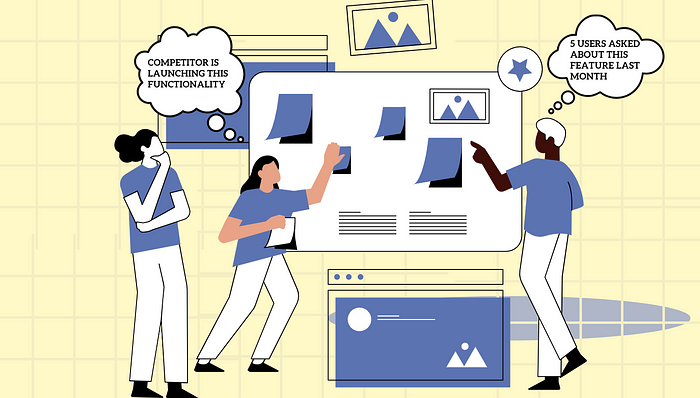Battling Availability Bias As a Product Manager
As product managers, we all have undoubtedly experienced the weight of product prioritization. Each decision we make carries significant consequences. We often find ourselves overwhelmed with a flood of information, opinions, and experiences. However, we must swiftly distinguish between beliefs and facts to make critical choices. We must recognize the mental traps that can cloud our judgment.
One common mental bias that tends to hide in the background is availability bias. This bias can subtly distort the decision-making process of product managers, especially when discussing product priorities with various customer-facing roles.
To ensure that our decisions are based on a comprehensive and unbiased evaluation of all product priorities, it is essential to understand and address the influence of the availability bias. This way, we can make informed decisions that are not swayed by misleading perceptions.

What is Availability Bias?
Throughout the course of our evolution, our brains have developed efficient systems to process information and make quick judgments for our survival. One such system is the availability bias.
This bias leads humans to heavily rely on information that comes to mind easily when making decisions. Our brains naturally consider information that is easily remembered or stands out as more important or likely to occur, even if that might not be true. We give greater significance to readily accessible information or experiences in our decision-making process, even if they may not be representative or accurate.
In product management, availability bias can cause problems when we prioritize easily accessible information, which may be incomplete or misleading, over a thorough and accurate understanding of the situation. Let’s take an example: At some point, every product manager is likely to hear a question like this: “Last month, I had 5 customers mention this functionality. Shouldn’t we prioritize it and put it on the roadmap?”
However, the fact that a feature request was mentioned 5 times in a month doesn’t automatically make it critical. There could be other product opportunities or feature requests from more important customers, or strategic projects that need attention (like developing new product differentiators).
The danger lies in the risks associated with falling into this cognitive trap. Making decisions solely based on the frequency of mention can have long-lasting consequences for the product.
Risks Associated With Availability Bias
First, this mental shortcut can lead to a biased sample of user data and their issues. When we focus only on recent user interactions, we might miss the needs of other users with more critical requirements. This can skew our understanding of the target audience’s needs and prevent us from fully grasping their challenges. Keep in mind that the most vocal customers may not necessarily represent your ideal user.
Secondly, by relying solely on easily accessible data and information, we voluntarily limit our perspective on the subject matter, putting valuable insights and potential innovation opportunities at risk of being overlooked. As Product managers, we should actively strive to expand our understanding of the problem space through ongoing product discovery. Additionally, we should synthesize additional context from sales and expansion data, competition analysis, or market trends. To make informed decisions during prioritization, it’s crucial to gather as much comprehensive information about our product situation as possible.
Furthermore, neglecting continuous product discovery and relying solely on recent customer feedback can lead to incorrect design decisions. Users may not always be aware of or able to articulate their underlying needs accurately. Relying solely on their input may result in a design that only addresses surface-level issues.
There is also a risk when it comes to achieving strategic goals. The availability bias tends to favor immediate and easily remembered information, often emphasizing very recent data. This can divert our focus away from long-term strategic objectives. This short-sighted approach can negatively impact the product roadmap, strategy, and overall customer satisfaction. It overlooks the broader vision and long-term development of the product.
How Can We Overcome It?
When it comes to overcoming availability bias, awareness is key. Simply understanding this bias and its impact on decision-making can greatly help combat its influence. By recognizing its presence and effect on our past work, we can actively challenge assumptions and strive for a more balanced perspective when evaluating product opportunities or issues.
One effective way to develop this perspective is by centralizing our product data and feedback. By gathering all relevant information in one place, we gain a comprehensive view of our customer’s problems and needs. This broader perspective aids in evaluating product ideas and feature requests. Centralizing data also provides evidence for prioritization discussions and resolving customer issues, helping us focus on what truly matters.
However, it’s important to regularly share this knowledge with stakeholders and colleagues outside the product department. As product managers, we possess a deeper understanding of the broader customer context. It’s crucial to explain the reasons behind our product focus. Regular communication is vital for long-term alignment and can uncover additional context.
Most importantly, our decision-making should align with the long-term product vision and business strategy. The reality is that we will never have enough development capacity to address every customer need and feature request simultaneously while executing the ideal product plan. This leads to tough prioritization discussions, where different stakeholders may push for different priorities. Our product vision and strategy become invaluable assets in these challenging moments. As product managers, it’s our responsibility to ensure all product priorities align with them.
Availability bias can quickly become the greatest challenge for a product manager, leading to distorted priorities, missed opportunities, and compromised long-term strategic goals. However, it’s a battle we must take on to elevate our performance and concentrate on what truly matters.
Furthermore, the more we conquer this bias, the more we’ll find ourselves honing our focus, effortlessly prioritizing tasks, and streamlining everyday discussions.